Assessment of Machining of Hastelloy Using WEDM by a Multi-Objective Approach
Abstract
1. Introduction
2. Materials and Methods
Development of Anticipated Grey ANN Model
3. Results and Discussions
3.1. Optimization of Material Removal Rate (MRR)
3.2. Optimization of Surface Roughness (SR)
3.3. Optimization of Dimensional Deviation
3.4. Optimization of Circularity and Perpendicularity Errors
3.5. Significance Analysis for Chosen Output Measures
Prediction of Performance Measure by Neural Network Model
3.6. Analysis on the Evolved Neural Network Model
3.7. Comparison on Actual and Prophesied GRG
4. Conclusions
- The WEDM trials utilized the L27 orthogonal array of Taguchi as the basis for their performance characteristics.
- The approach utilized by Taguchi determines the optimal set of variables for each output.
- The aspiration of the analysis was to determine the various parameters that impact the performance of Hastelloy during the WEDM procedure. It was revealed that the current was the important factor that affected the alloy’s performance.
- The data collected from the relational coefficient are then fed into the WEDM process model. It predicts the ANN-GRG values.
- The outcome of the exploratory investigation suggested that the Grey-ANN model can predict Hastelloy’s performance during WEDM. It also noted that the anticipated ANN-GRG model could enhance the prediction competence of the model.
- The findings of the study indicated that the ANN method can be exploited for various advanced machining processes.
Author Contributions
Funding
Institutional Review Board Statement
Informed Consent Statement
Data Availability Statement
Acknowledgments
Conflicts of Interest
References
- Everhart, J. Engineering Properties of Nickel and Nickel Alloys; Springer Science & Business Media: Berlin/Heidelberg, Germany, 2012. [Google Scholar]
- Thejasree, P.; Manikandan, N.; Binoj, J.S.; Varaprasad, K.C.; Palanisamy, D.; Ramesh, R. Numerical Simulation and Experimental Investigation on Laser Beam Welding of Inconel 625. Mater. Today Proc. 2021, 39, 268–273. [Google Scholar] [CrossRef]
- Sharma, P.; Chakradhar, D.; Narendranath, S. Evaluation of WEDM performance characteristics of Inconel 706 for turbine disk application. Mater. Des. 2015, 88, 558–566. [Google Scholar] [CrossRef]
- Jadam, T.; Sahu, S.K.; Datta, S.; Masanta, M. EDM performance of Inconel 718 superalloy: Application of multi-walled carbon nanotube (MWCNT) added dielectric media. J. Braz. Soc. Mech. Sci. Eng. 2019, 41, 305. [Google Scholar] [CrossRef]
- Sharma, P.; Chakradhar, D.S.N. Analysis and Optimization of WEDM Performance Characteristics of Inconel 706 for Aerospace Application. Silicon 2018, 10, 921–930. [Google Scholar] [CrossRef]
- Ho, K.H.; Newman, S.T. State of the art electrical discharge machining (EDM). Int. J. Mach. Tools Manuf. 2003, 43, 1287–1300. [Google Scholar] [CrossRef]
- Manikandan, N.; Binoj, J.; Thejasree, P.; Sasikala, P.; Anusha, P. Application of Taguchi method on Wire Electrical Discharge Machining of Inconel 625. Mater. Today Proc. 2021, 39, 121–125. [Google Scholar] [CrossRef]
- Kliuev, M.; Florio, K.; Akbari, M.; Wegener, K. Influence of energy fraction in EDM drilling of Inconel 718 by statistical analysis and finite element crater-modelling. J. Manuf. Process. 2019, 40, 84–93. [Google Scholar] [CrossRef]
- El-Hofy, H. Advanced Machining Processes; McGraw-Hill: New York, NY, USA, 2005. [Google Scholar]
- Li, X.; Yan, F.; Ma, J.; Chen, Z.; Wen, X.; Cao, Y. RBF and NSGA-II based EDM process parameters optimization with multiple constraints. Math. Biosci. Eng. 2019, 16, 5788–5803. [Google Scholar]
- Buschaiah, K.; JagadeeswaraRao, M.; Krishnaiah, A. Investigation on the Influence of Edm Parameters on Machining Characteristics for Aisi 304. Mater. Today Proc. 2018, 5, 3648–3656. [Google Scholar] [CrossRef]
- Palanisamy, D.; Devaraju, A.; Manikandan, N.; Balasubramanian, K.; Arulkirubakaran, D. Experimental investigation and optimization of process parameters in EDM of aluminium metal matrix composites. Mater. Today Proc. 2020, 22, 525–530. [Google Scholar] [CrossRef]
- Thejasree, P.; Binoj, J.S.; Krishnamachary, P.C.; Manikandan, N.; Palanisamy, D. Experimental Analysis on Wire Electrical Discharge Machining of Inconel 718 Using Taguchi’s Method. Adv. Ind. Autom. Smart Manuf. Lect. Notes Mech. Eng. 2020, 497–504. [Google Scholar] [CrossRef]
- Manikandan, N.; Thejasree, P.; Raju, R.; Palanisamy, D.; Varaprasad, K.C.; Britto, A.S.F.; Sai, A.D.C. Investigations on Wire Electrical Discharge Machining of Titanium Alloys by Taguchi—Grey Approach; Springer: Singapore, 2022. [Google Scholar] [CrossRef]
- Boopathi, S. Cryogenically treated and untreated stainless steel grade 317 in sustainable wire electrical discharge machining process: A comparative study. Environ. Sci. Pollut. Res. 2022, 56, 1–10. [Google Scholar] [CrossRef]
- Pramanik, A.; Basak, A. Sustainability in wire electrical discharge machining of titanium alloy: Understanding wire rupture. J. Clean. Prod. 2018, 198, 472–479. [Google Scholar] [CrossRef]
- Camposeco-Negrete, C. Analysis and optimization of sustainable machining of AISI O1 tool steel by the wire-EDM process. Adv. Manuf. 2021, 9, 304–317. [Google Scholar] [CrossRef]
- Yan, H.; Djo Bakadiasa, K.; Yan, Z.; Han, F.; Chen, Z. Sustainable production of high-uniformity workpiece surface quality in wire electrical discharge machining by fabricating surface microstructure on wire electrode. J. Clean. Prod. 2020, 259, 120881. [Google Scholar] [CrossRef]
- Deng, J. Introduction to grey system. J. Grey Syst. 1989, 1, 1–24. [Google Scholar]
- Manikandan, N.; Varaprasad, K.C.; Thejasree, P.; Palanisamy, D.; Arulkirubakaran, D.; Raju, R.; Badrinath, K. Prediction of Performance Measures Using Multiple Regression Analysis for Wire Electrical Discharge Machining of Titanium Alloy; Springer: Singapore, 2022. [Google Scholar] [CrossRef]
- Palanisamy, D.; Senthil, P. Optimization on turning parameters of 15-5PH stainless steel using Taguchi based grey approach and TOPSIS. Arch. Mech. Eng. 2016, 63, 397–412. [Google Scholar] [CrossRef]
- Bhuyan, R.K.; Shalini, M.; Routara, B.C. RSM and Fuzzy logic approaches for predicting the surface roughness during EDM of Al-SiCp MMC. Mater. Today Proc. 2017, 4, 1947–1956. [Google Scholar] [CrossRef]
- Patel Gowdru Chandrashekarappa, M.; Kumar, S.; Pimenov, D.Y.; Giasin, K. Experimental analysis and optimization of EDM parameters on HcHcr steel in context with different electrodes and dielectric fluids using hybrid taguchi-based PCA-utility and CRITIC-utility approaches. Metals 2021, 11, 419. [Google Scholar] [CrossRef]
- Rupesh, K.P.; Panda, S.S. Optimization of bone drilling parameters using grey-based fuzzy algorithm. Measurement 2014, 47, 386–392. [Google Scholar]
- Mithal, A.; Maharjan, N.; Idapalapati, S. Enhanced cooling rates in laser directed energy deposition with interlayer peening. Rapid Prototyp. J. 2023, 29, 1289–1298. [Google Scholar] [CrossRef]
- Khorasani, M.; Ghasemi, A.H.; Farabi, E.; Leary, M.; Gibson, I.; Rolfe, B. A comprehensive investigation of abrasive barrel finishing on hardness and manufacturability of laser-based powder bed fusion hollow components. Int. J. Adv. Manuf. Technol. 2022, 120, 3471–3490. [Google Scholar] [CrossRef]
- Pradhan, M.K.; Biswas, C.K. Neuro-fuzzy and neural network-based prediction of various responses in electrical discharge machining of AISID2 steel: NF and NN based prediction of responses in EDM of D2 steel. Int. J. Adv. Manuf. Technol. 2010, 50, 591–610. [Google Scholar] [CrossRef]
- Dimla, D.E., Jr.; Lister, P.M.; Leighton, N.J. Neural network solutions to the tool condition monitoring problem in metal cutting —Acritical reviewof methods. Int. J. Mach. Tools Manuf. 1997, 37, 1219–1241. [Google Scholar] [CrossRef]
- Dini, G. Literature database on applications of artificial intelligence methods in manufacturing engineering. Ann. CIRP 1997, 46, 681–690. [Google Scholar]
- Manikandan, N.; Ramesh Raju, D.; Palanisamy, J.S.B. Optimization of Spark Erosion Machining Process Parameters using Hybrid Grey Relational Analysis and Artificial Neural Network Model. Int. J. Mach. Mach. Mater. 2020, 22, 1–23. [Google Scholar]
- Kao, J.Y.; Tarng, Y.S. A neural network approach for the on-line monitoring of the electrical discharge machining process. J. Mater. Process. Technol. 1997, 69, 112–119. [Google Scholar] [CrossRef]
- Quarto, M.; D’Urso, G.; Giardini, C. Micro-EDM optimization through particle swarm algorithm and artificial neural network. Precis. Eng. 2022, 73, 63–70. [Google Scholar] [CrossRef]
- Saffaran, A.; Moghaddam, M.A.; Kolahan, F. Optimization of backpropagation neural network-based models in EDM process using particle swarm optimization and simulated annealing algorithms. J. Braz. Soc. Mech. Sci. Eng. 2020, 42, 1–14. [Google Scholar] [CrossRef]
- Demuth, H.; Beale, M. Neural Network Toolbox User’s Guide, Version 8.2 (Release 2014a); The Mathworks, Inc.: Natick, MA, USA, 2000. [Google Scholar]
- Alduroobi, A.A.A.; Alaa, M.; Ubaid, M.A.T.; Elias, R.R. Wire EDM process optimization for machining AISI 1045 steel by use of Taguchi method, artificial neural network and analysis of variances. Int. J. Syst. Assur. Eng. Manag. 2020, 11, 1314–1338. [Google Scholar] [CrossRef]
- Nichols, G.P.; Fontenot, J.D.; Gibbons, J.P.; Sanders, M. Multi-response optimization of machining parameters of Ti-6Al-2Sn-4Zr-2Mo alloy using EDM process through grey relational analysis. Eng. Res. Express 2023, 5, 025005. [Google Scholar] [CrossRef]
- Santosh, P.; Narendranath, V.; Balaji, I.V.; Manoj, V.; Keshav, H.J. Prediction of Machining Characteristics of Wire Electrical Discharge Machined Hastelloy-X using Artificial Neural Network. IOP Conf. Ser. Mater. Sci. Eng. 2022, 1248, 012049. [Google Scholar] [CrossRef]
- Karkalos, N.E.; Karmiris-Obratański, P.; Kudelski, R.; Markopoulos, A.P. Experimental Study on the Sustainability Assessment of AWJ Machining of Ti-6Al-4V Using Glass Beads Abrasive Particles. Sustainability 2021, 13, 8917. [Google Scholar] [CrossRef]
- Krolczyk, G.M.; Maruda, R.W.; Krolczyk, J.B.; Wojciechowski, S.; Mia, M.; Nieslony, P.; Budzik, G. Ecological trends in machining as a key factor in sustainable production—A review. J. Clean. Prod. 2019, 218, 601–615. [Google Scholar] [CrossRef]
- Nieslony, P.; Wojciechowski, S.; Gupta, M.; Chudy, R.; Krolczyk, J.; Maruda, R.; Krolczyk, G. Relationship between energy consumption and surface integrity aspects in electrical discharge machining of hot work die steel. Sustain. Mater. Technol. 2023, 36, e00623. [Google Scholar] [CrossRef]
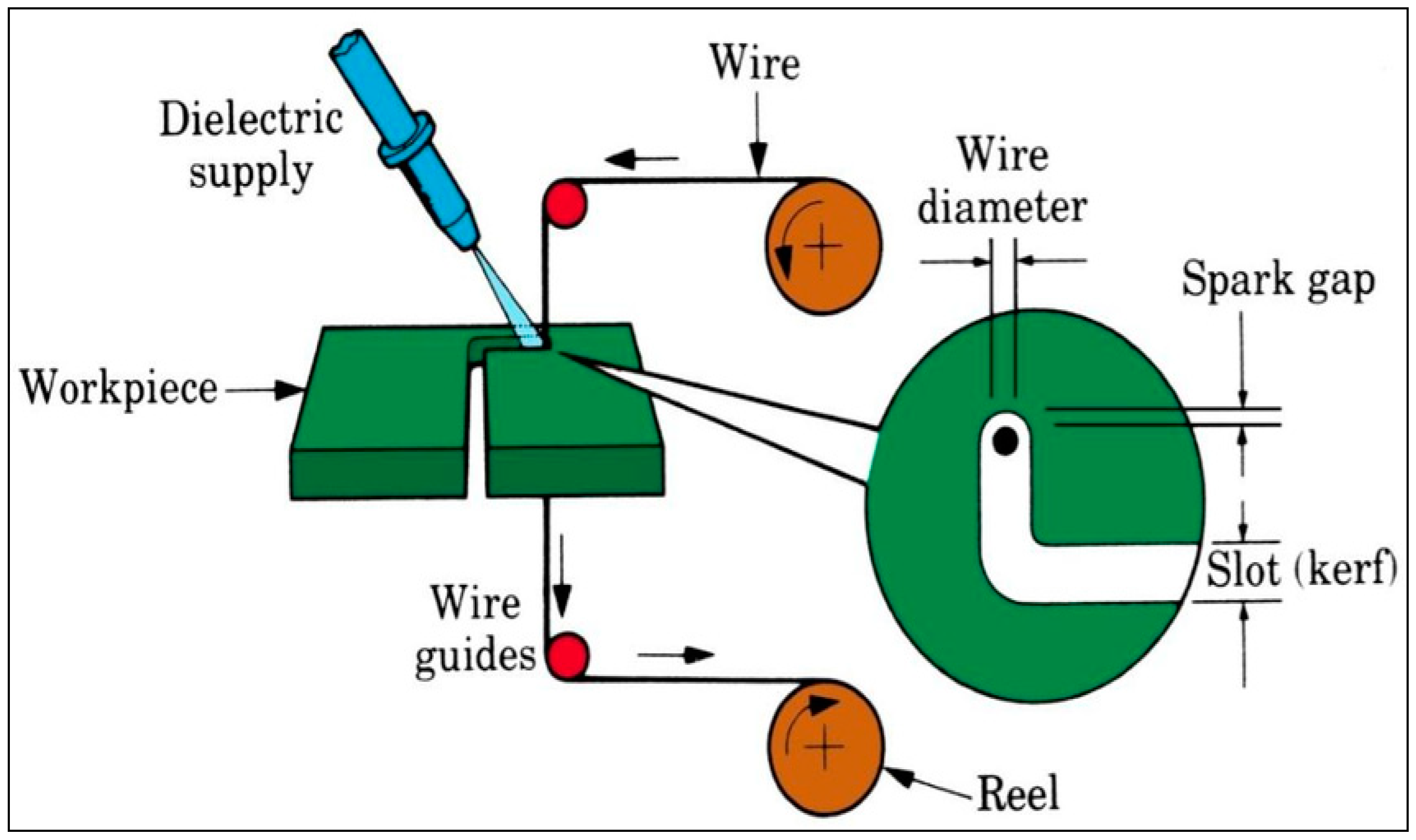

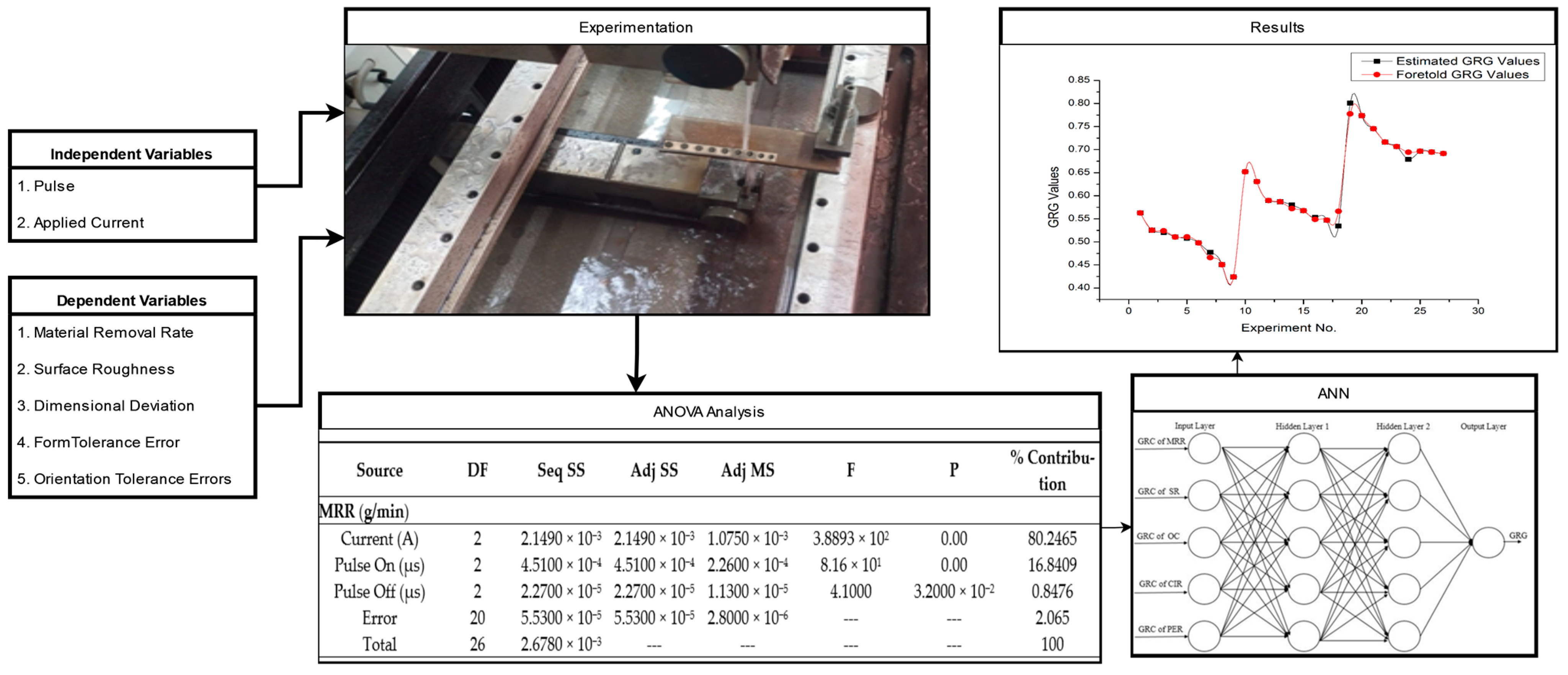
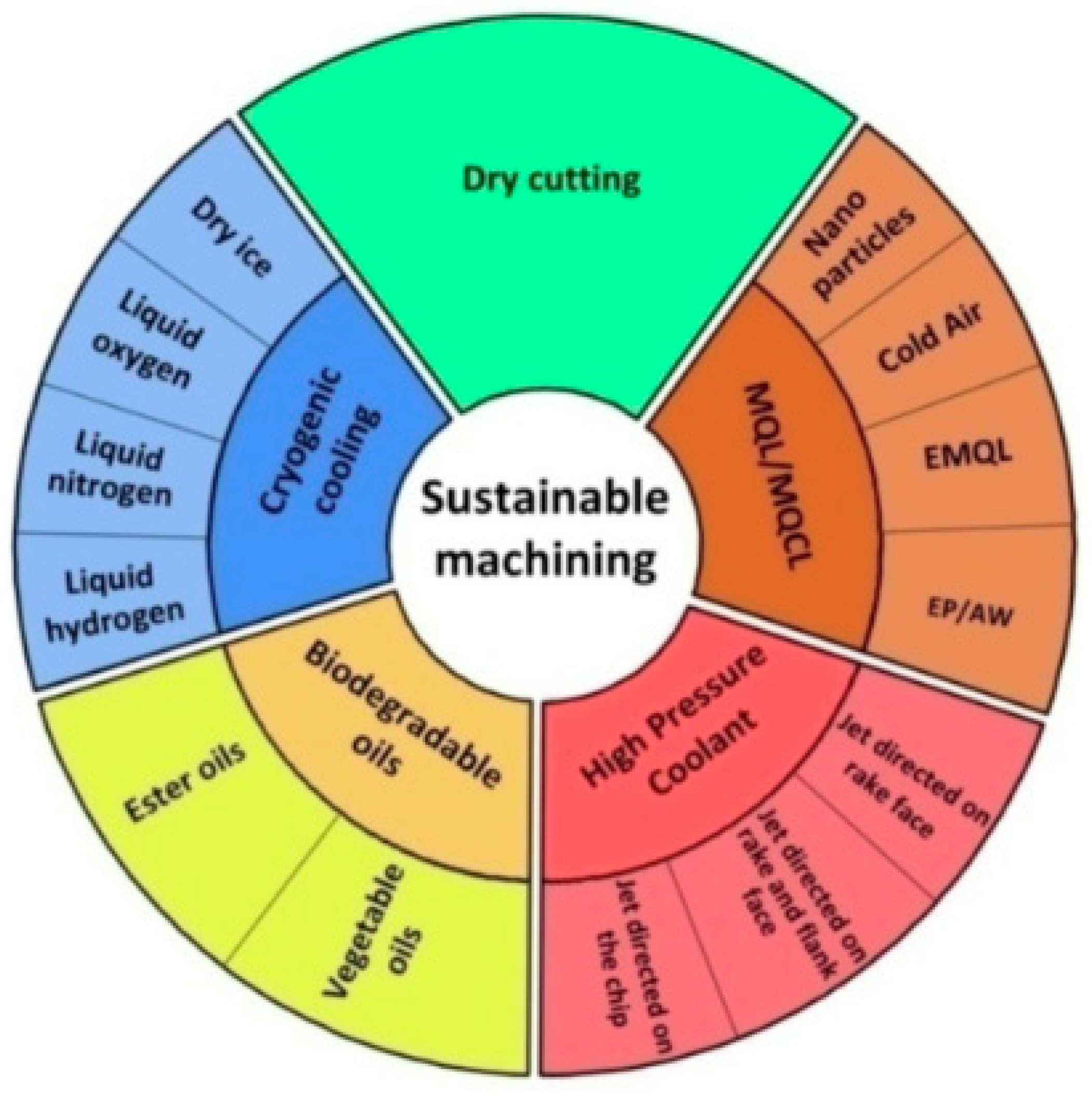
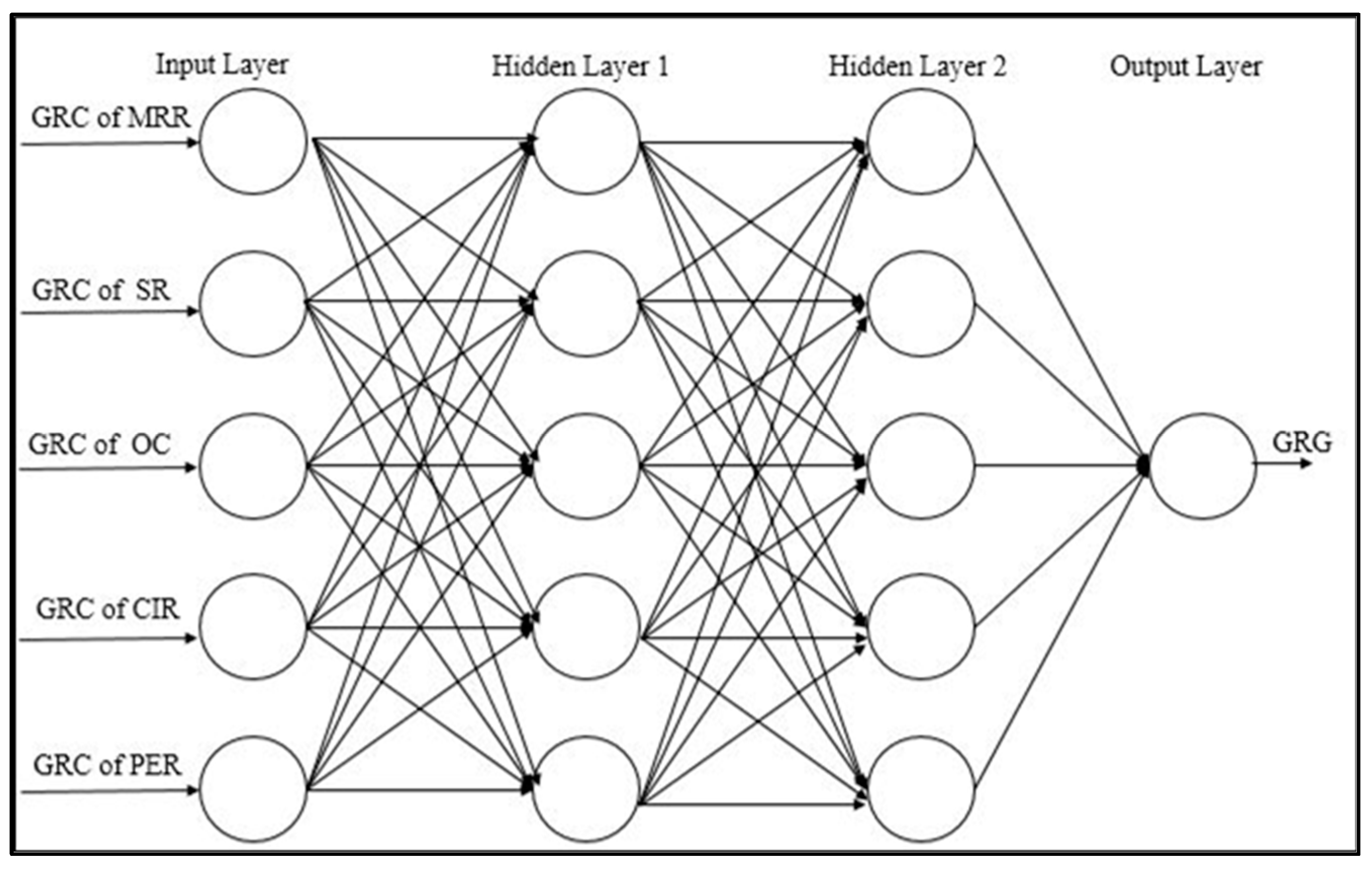
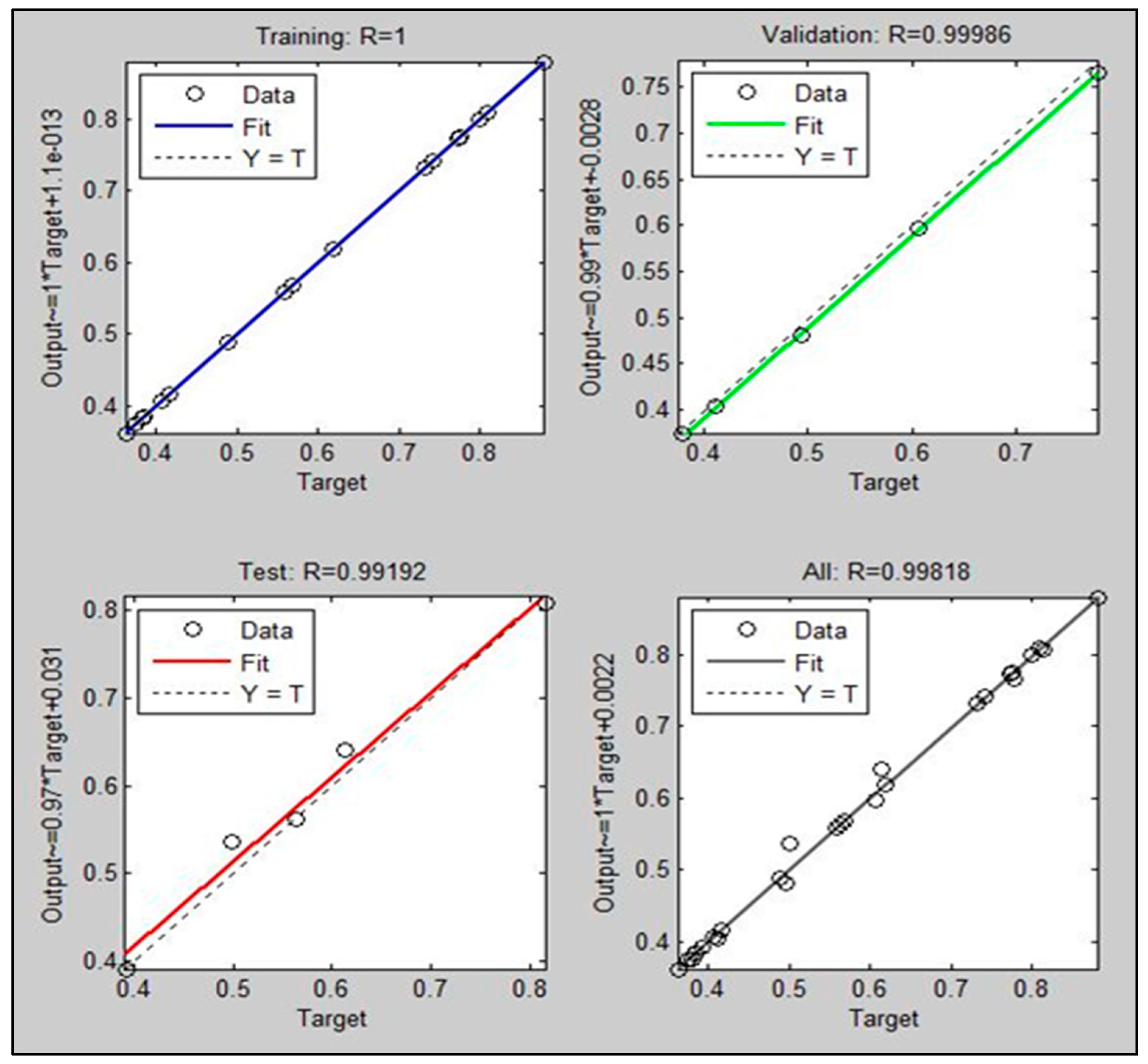
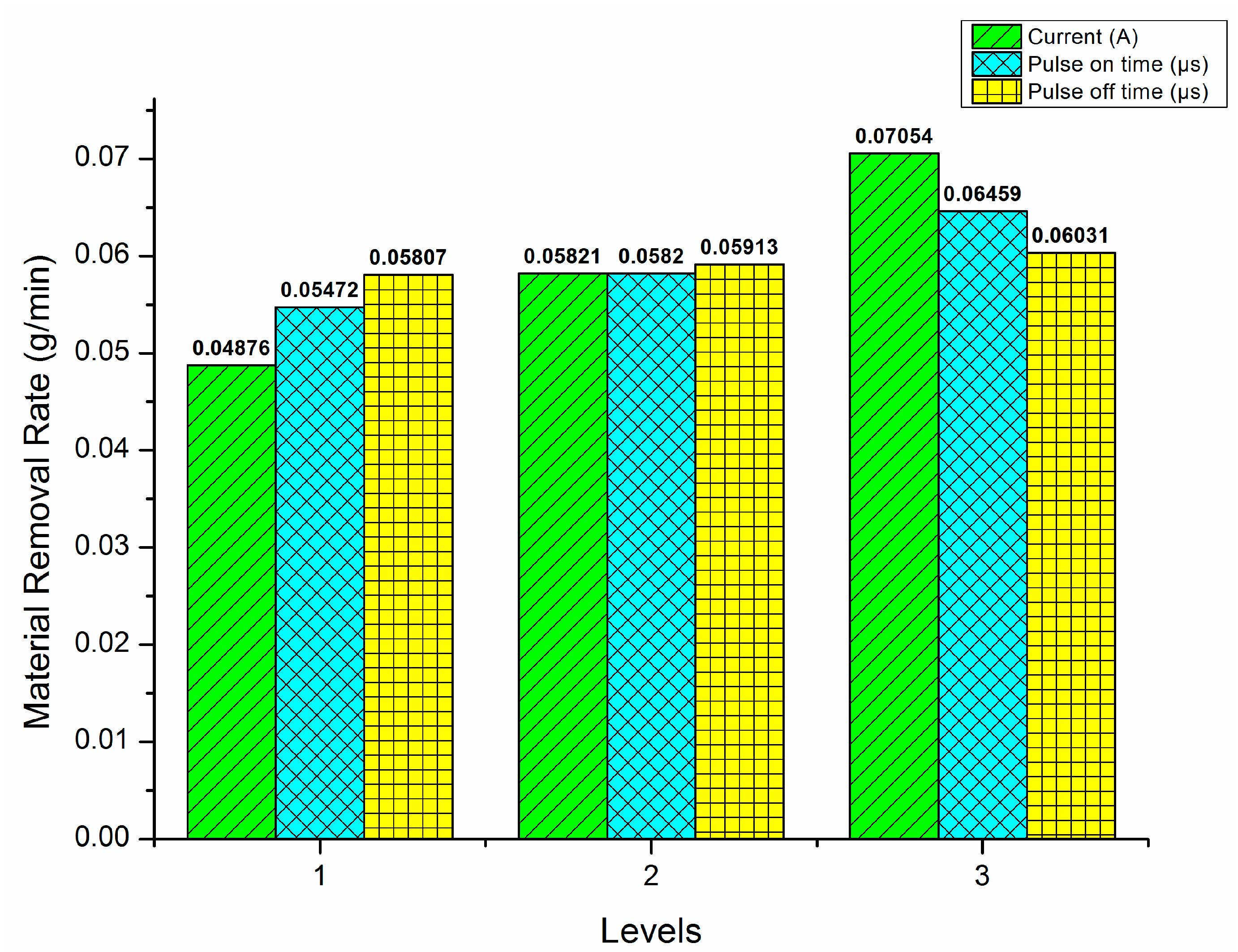

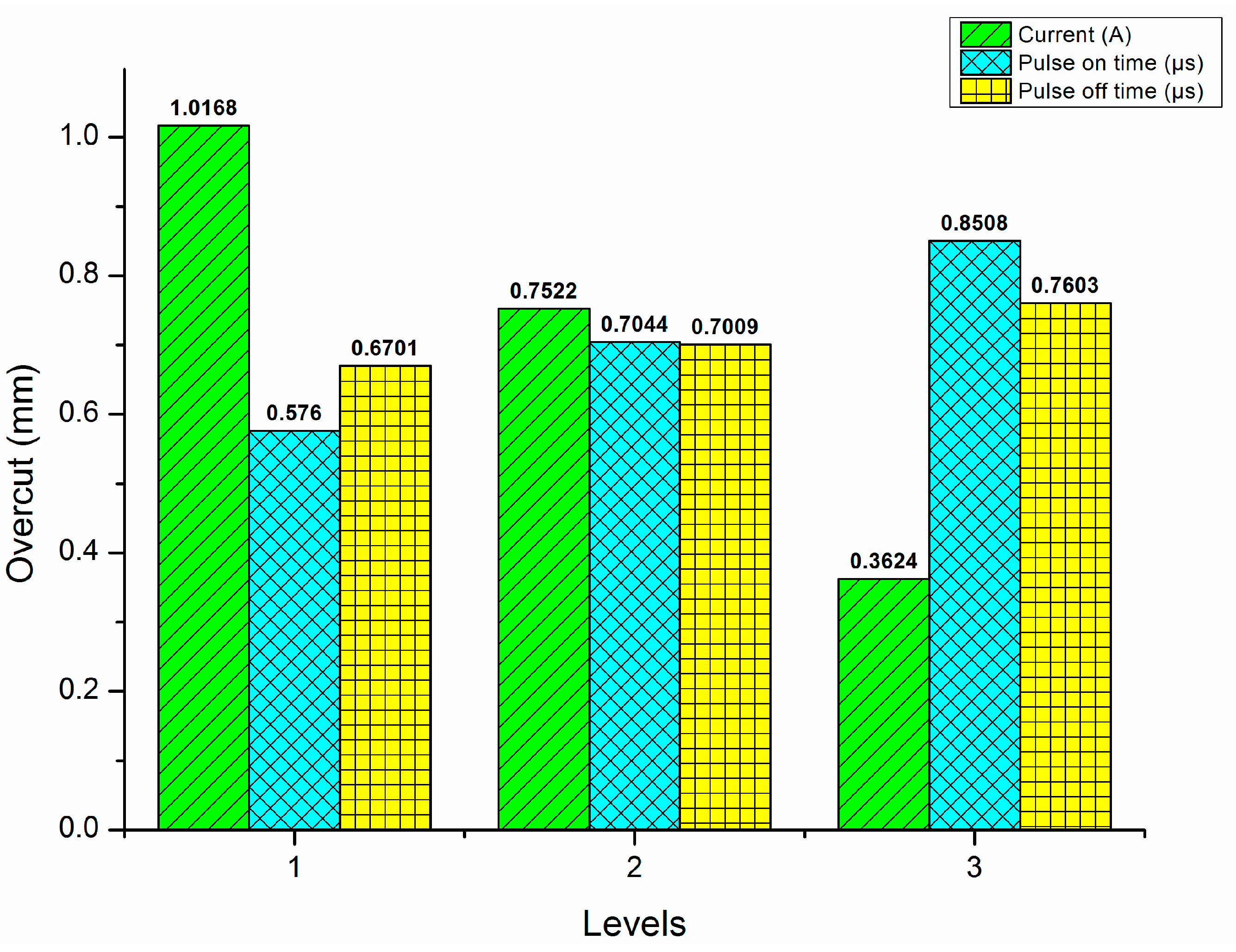
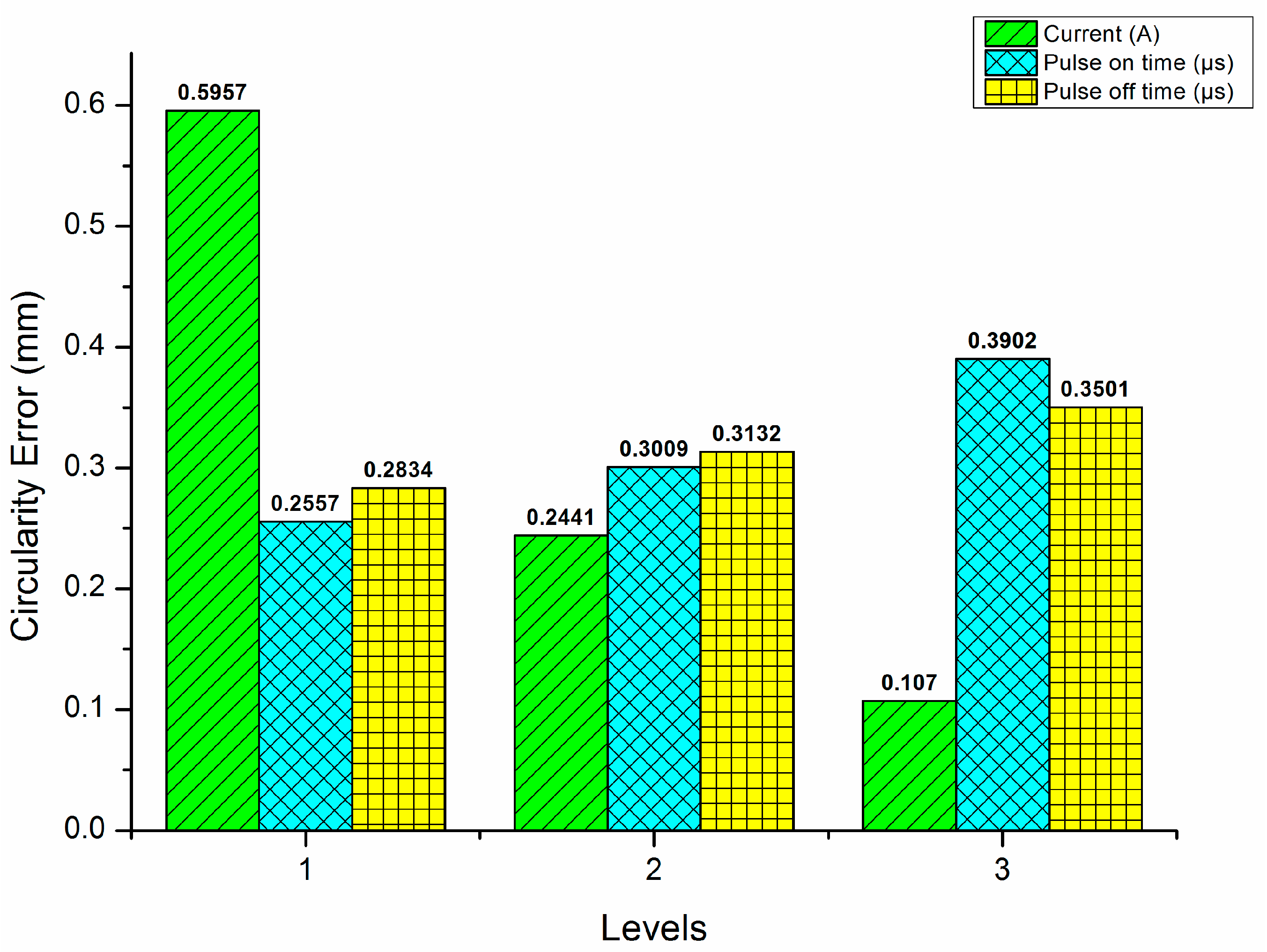
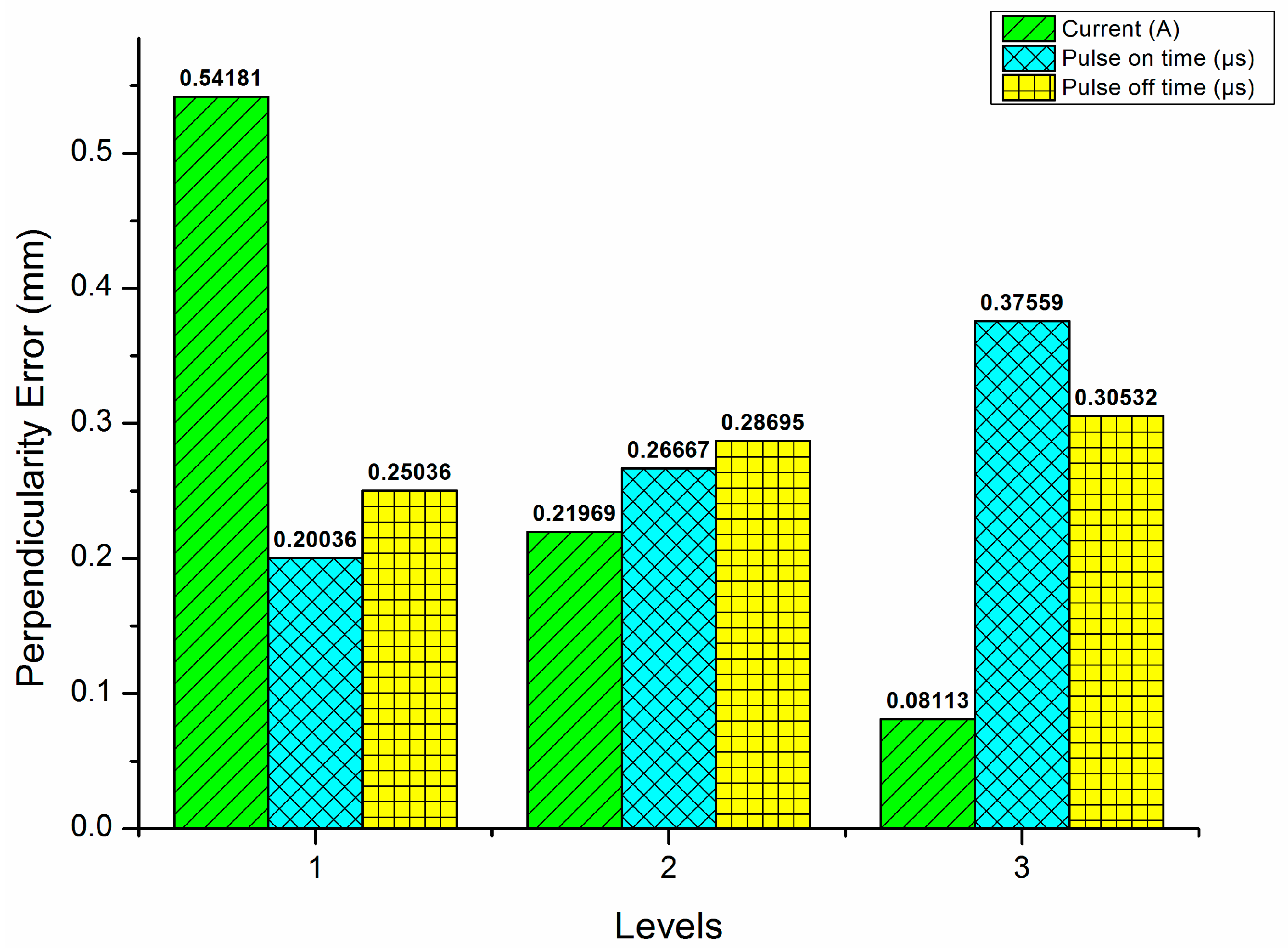
| Symbols | Process Variables | Levels | ||
|---|---|---|---|---|
| 1 | 2 | 3 | ||
| A | Applied Current (A) | 5 | 10 | 15 |
| B | Ton (µs) | 30 | 60 | 90 |
| C | Toff (µs) | 3 | 6 | 9 |
| Trial No | Structure | R Values | |||
|---|---|---|---|---|---|
| Training Set | Validation Set | Testing Set | Overall | ||
| 1 | 5-16-16-1 | 1 | 0.8398 | 0.9051 | 0.9715 |
| 2 | 5-16-20-1 | 1 | 9.9819 | 0.9739 | 0.9724 |
| 3 | 5-18-12-1 | 1 | 0.9889 | 0.9980 | 0.9979 |
| 4 | 5-18-14-1 | 1 | 0.9959 | 0.9980 | 0.9985 |
| 5 | 5-18-16-1 | 1 | 0.6958 | 0.9549 | 0.9264 |
| 6 | 5-18-18-1 | 1 | 0.9972 | 0.9952 | 0.9986 |
| 7 | 5-18-20-1 | 1 | 0.9951 | 0.9235 | 0.9804 |
| 8 | 5-20-12-1 | 1 | 0.9963 | 0.9952 | 0.9989 |
| 9 | 5-20-14-1 | 1 | 0.4950 | 0.92997 | 0.8562 |
| 10 | 5-20-16-1 | 1 | 0.9953 | 0.9979 | 0.9972 |
| 11 | 5-20-18-1 | 1 | 0.9998 | 0.9919 | 0.9981 |
| 12 | 5-20-20-1 | 1 | 0.9858 | 0.9956 | 0.9980 |
| Source | DF | Seq SS | Adj SS | Adj MS | F | P | % Contribution |
|---|---|---|---|---|---|---|---|
| MRR (g/min) | |||||||
| Current (A) | 2 | 2.1490 × 10−3 | 2.1490 × 10−3 | 1.0750 × 10−3 | 3.8893 × 102 | 0.00 | 80.2465 |
| Pulse On (µs) | 2 | 4.5100 × 10−4 | 4.5100 × 10−4 | 2.2600 × 10−4 | 8.16 × 101 | 0.00 | 16.8409 |
| Pulse Off (µs) | 2 | 2.2700 × 10−5 | 2.2700 × 10−5 | 1.1300 × 10−5 | 4.1000 | 3.2000 × 10−2 | 0.8476 |
| Error | 20 | 5.5300 × 10−5 | 5.5300 × 10−5 | 2.8000 × 10−6 | --- | --- | 2.065 |
| Total | 26 | 2.6780 × 10−3 | --- | --- | --- | --- | 100 |
| SR (Ra) (microns) | |||||||
| Current (A) | 2 | 1.4876 × 10−1 | 1.4876 × 10−1 | 7.4381 × 10−2 | 4.8045 × 102 | 0.00 | 91.3862 |
| Pulse On (µs) | 2 | 8.9190 × 10−3 | 8.9190 × 10−3 | 4.4590 × 10−3 | 2.8800 × 101 | 0.00 | 5.479 |
| Pulse Off (µs) | 2 | 2.0070 × 10−3 | 2.0070 × 10−3 | 1.0040 × 10−3 | 6.48 | 7.00 × 10−3 | 1.2329 |
| Error | 20 | 3.0960 × 10−3 | 3.0960 × 10−3 | 1.5500 × 10−4 | --- | --- | 1.9019 |
| Total | 26 | 0.162785 | --- | --- | --- | --- | 100 |
| DD (mm) | |||||||
| Current (A) | 2 | 1.9507 | 1.9507 | 9.7533 × 10−1 | 3.3418 × 102 | 0.00 | 81.7163 |
| Pulse On (µs) | 2 | 3.4025 × 10−1 | 3.4025 × 10−1 | 1.7012 × 10−1 | 5.8290 × 101 | 0.00 | 14.2537 |
| Pulse Off (µs) | 2 | 3.7830 × 10−2 | 3.7830 × 10−2 | 1.8920 × 10−2 | 6.480 | 7.00 × 10−3 | 1.5848 |
| Error | 20 | 5.8370 × 10−2 | 5.8370 × 10−2 | 2.9200 × 10−3 | --- | --- | 2.4452 |
| Total | 26 | 2.3871 | --- | --- | --- | --- | 100 |
| Circularity error (mm) | |||||||
| Current (A) | 2 | 1.1434 | 1.1434 | 5.7170 × 10−1 | 1.9537 × 102 | 0.00 | 87.5297 |
| Pulse On (µs) | 2 | 8.4200 × 10−2 | 8.4200 × 10−2 | 4.2100 × 10−2 | 1.4390 × 101 | 0.00 | 6.4457 |
| Pulse Off (µs) | 2 | 2.0100 × 10−2 | 2.0100 × 10−2 | 1.0100 × 10−2 | 3.4400 | 5.2000 × 10−2 | 1.5387 |
| Error | 20 | 5.8500 × 10−2 | 5.8500 × 10−2 | 2.9000 × 10−3 | --- | --- | 4.5783 |
| Total | 26 | 1.3063 | --- | --- | --- | --- | 100 |
| Perpendicularity error (mm) | |||||||
| Current (A) | 2 | 1.0056 | 1.0056 | 5.0280 × 10−1 | 1.5959 × 102 | 0.00 | 82.1837 |
| Pulse On (µs) | 2 | 1.4090 × 10−1 | 1.4090 × 10−1 | 7.0500 × 10−2 | 2.2360 × 101 | 0.00 | 11.5152 |
| Pulse Off (µs) | 2 | 1.4100 × 10−2 | 1.4100 × 10−2 | 7.1000 × 10−3 | 2.2400 | 1.33 × 10−1 | 1.1523 |
| Error | 20 | 6.3000 × 10−2 | 6.3000 × 10−2 | 3.2000 × 10−3 | --- | --- | 5.1487 |
| Total | 26 | 1.2236 | --- | --- | --- | --- | 100 |
| GRG and GRG Values | ||||||
|---|---|---|---|---|---|---|
| MRR | SR | DD | Circularity Error | Perpendicularity Error | GRG | Rank |
| 0.3333 | 1.0000 | 0.4423 | 0.5379 | 0.5005 | 0.5628 | 16 |
| 0.3381 | 0.8667 | 0.4360 | 0.4857 | 0.5000 | 0.5253 | 20 |
| 0.3481 | 0.8667 | 0.4278 | 0.4606 | 0.4985 | 0.5203 | 21 |
| 0.3628 | 0.8667 | 0.4239 | 0.4596 | 0.4402 | 0.5106 | 22 |
| 0.3692 | 0.8667 | 0.4232 | 0.4443 | 0.4366 | 0.5080 | 23 |
| 0.3859 | 0.8125 | 0.4225 | 0.4343 | 0.4333 | 0.4977 | 24 |
| 0.3915 | 0.7647 | 0.3781 | 0.4205 | 0.4326 | 0.4775 | 25 |
| 0.3948 | 0.7647 | 0.3566 | 0.3923 | 0.3443 | 0.4506 | 26 |
| 0.3973 | 0.7222 | 0.3333 | 0.3333 | 0.3333 | 0.4239 | 27 |
| 0.4041 | 0.7222 | 0.6028 | 0.7440 | 0.7871 | 0.6520 | 10 |
| 0.4093 | 0.6842 | 0.5734 | 0.7372 | 0.7483 | 0.6305 | 11 |
| 0.4147 | 0.5652 | 0.5005 | 0.7225 | 0.7456 | 0.5897 | 12 |
| 0.4309 | 0.5652 | 0.4852 | 0.7205 | 0.7325 | 0.5869 | 13 |
| 0.4420 | 0.5652 | 0.4798 | 0.7155 | 0.6974 | 0.5800 | 14 |
| 0.4493 | 0.5652 | 0.4696 | 0.6775 | 0.6771 | 0.5677 | 15 |
| 0.4954 | 0.5417 | 0.4580 | 0.6592 | 0.6097 | 0.5528 | 17 |
| 0.5171 | 0.5417 | 0.4578 | 0.6379 | 0.5803 | 0.5470 | 18 |
| 0.5302 | 0.5200 | 0.4479 | 0.6365 | 0.5379 | 0.5345 | 19 |
| 0.5393 | 0.4643 | 1.0000 | 1.0000 | 1.0000 | 0.8007 | 1 |
| 0.5456 | 0.4063 | 0.9546 | 0.9673 | 0.9942 | 0.7736 | 2 |
| 0.5569 | 0.3939 | 0.8533 | 0.9520 | 0.9711 | 0.7454 | 3 |
| 0.5773 | 0.3939 | 0.7713 | 0.9270 | 0.9127 | 0.7164 | 4 |
| 0.5845 | 0.3939 | 0.7380 | 0.9261 | 0.8904 | 0.7066 | 5 |
| 0.5975 | 0.3939 | 0.6612 | 0.9066 | 0.8356 | 0.6790 | 9 |
| 0.7495 | 0.3714 | 0.6561 | 0.8871 | 0.8187 | 0.6966 | 6 |
| 0.8667 | 0.3514 | 0.6266 | 0.8125 | 0.8162 | 0.6947 | 7 |
| 1.0000 | 0.3333 | 0.5492 | 0.7817 | 0.7932 | 0.6915 | 8 |
| Performance Measures | Values |
|---|---|
| MAPE | 0.6263 |
| RMSE | 0.0086 |
| MAE | 6.263 × 10−3 |
| Correlation Coefficient | 0.9981 |
| S. No | GRG Values | |
|---|---|---|
| Estimated | Foretold | |
| 1 | 0.5628 | 0.5628 |
| 2 | 0.5253 | 0.5253 |
| 3 | 0.5203 | 0.5240 |
| 4 | 0.5106 | 0.5106 |
| 5 | 0.5080 | 0.5108 |
| 6 | 0.4977 | 0.4977 |
| 7 | 0.4775 | 0.4660 |
| 8 | 0.4506 | 0.4506 |
| 9 | 0.4239 | 0.4239 |
| 10 | 0.6520 | 0.652 |
| 11 | 0.6305 | 0.6305 |
| 12 | 0.5897 | 0.5897 |
| 13 | 0.5869 | 0.5869 |
| 14 | 0.5800 | 0.5723 |
| 15 | 0.5677 | 0.5677 |
| 16 | 0.5528 | 0.5487 |
| 17 | 0.5470 | 0.5470 |
| 18 | 0.5345 | 0.5662 |
| 19 | 0.8007 | 0.7775 |
| 20 | 0.7736 | 0.7736 |
| 21 | 0.7454 | 0.7454 |
| 22 | 0.7164 | 0.7164 |
| 23 | 0.7066 | 0.7066 |
| 24 | 0.6790 | 0.6943 |
| 25 | 0.6966 | 0.6966 |
| 26 | 0.6947 | 0.6947 |
| 27 | 0.6915 | 0.6915 |
Disclaimer/Publisher’s Note: The statements, opinions and data contained in all publications are solely those of the individual author(s) and contributor(s) and not of MDPI and/or the editor(s). MDPI and/or the editor(s) disclaim responsibility for any injury to people or property resulting from any ideas, methods, instructions or products referred to in the content. |
© 2023 by the authors. Licensee MDPI, Basel, Switzerland. This article is an open access article distributed under the terms and conditions of the Creative Commons Attribution (CC BY) license (https://creativecommons.org/licenses/by/4.0/).
Share and Cite
Natarajan, M.; Pasupuleti, T.; Abdullah, M.M.S.; Mohammad, F.; Giri, J.; Chadge, R.; Sunheriya, N.; Mahatme, C.; Giri, P.; Soleiman, A.A. Assessment of Machining of Hastelloy Using WEDM by a Multi-Objective Approach. Sustainability 2023, 15, 10105. https://doi.org/10.3390/su151310105
Natarajan M, Pasupuleti T, Abdullah MMS, Mohammad F, Giri J, Chadge R, Sunheriya N, Mahatme C, Giri P, Soleiman AA. Assessment of Machining of Hastelloy Using WEDM by a Multi-Objective Approach. Sustainability. 2023; 15(13):10105. https://doi.org/10.3390/su151310105
Chicago/Turabian StyleNatarajan, Manikandan, Thejasree Pasupuleti, Mahmood M. S. Abdullah, Faruq Mohammad, Jayant Giri, Rajkumar Chadge, Neeraj Sunheriya, Chetan Mahatme, Pallavi Giri, and Ahmed A. Soleiman. 2023. "Assessment of Machining of Hastelloy Using WEDM by a Multi-Objective Approach" Sustainability 15, no. 13: 10105. https://doi.org/10.3390/su151310105
APA StyleNatarajan, M., Pasupuleti, T., Abdullah, M. M. S., Mohammad, F., Giri, J., Chadge, R., Sunheriya, N., Mahatme, C., Giri, P., & Soleiman, A. A. (2023). Assessment of Machining of Hastelloy Using WEDM by a Multi-Objective Approach. Sustainability, 15(13), 10105. https://doi.org/10.3390/su151310105






